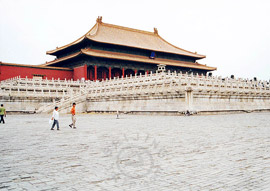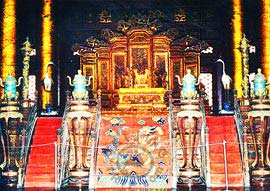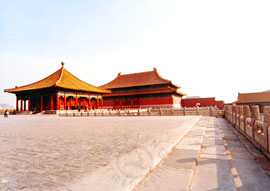 Hall of Supreme Harmony
Hall of Supreme Harmony

Hall of Supreme Harmony (Taihe Dian) also called 'Hall of Golden Throne', is the grandest hall in the palace and the largest wooden structure in China. It was originally constructed in 1402 during the Ming Dynasty (1368-1644), but was burnt down in later years. The present-day hall was rebuilt in 1695 by Emperor Kangxi, a sagacious emperor in the Qing Dynasty (1644-1911). During the dynasties, the hall was used to hold ceremonies on grand occasions, like the Emperor's enthronement, birthday and wedding day, the dispatch of generals to battles, the Winter Solstice and the Spring Festival.
This imposing hall, about 27 meters (88.5 feet) high, stands on a three-terrace base of white marble. The base is about eight meters (26 feet) high and is decorated with balusters with artistic design of dragons and phoenixes. Many stone dragons' heads on the balusters serve a practical purpose of drainage. On rainy days, over one thousand dragons on the terraces spout rainwater from their mouths at the same time. A marvelous scene!On the terrace are laid a sun dial and a standard measure which symbolize the unity of the state. There is also a pair of bronze cranes and a pair of tortoises, suggesting longevity. Eighteen bronze vessels, which are actually incense burners, are arranged in order. Three stairways lead to the hall and the one in the middle has a huge stone engraving with dragons playing with pearls.

As the symbol of imperial power, the interior of the hall is very luxurious. The floor is paved with golden bricks that are not really made of gold but really precious. In Chinese culture, the emperor is the incarnation of dragon. So the hall is dominated by dragon designs on the throne, columns, windows and ceilings. The golden throne sits on a platform in the north of the hall, with an elegant wall screen behind and three gilded columns on each side. In front of the throne, there are mythical beasts, cranes, and incense burners, which have their own symbolic meaning. The extraordinary ceiling above the throne changes in shape and has a dragon with a pearl in his mouth. The pearl is said to be able to distinguish whether the emperor is the legitimate inheritor or not. It would fall off the ceiling if an illegitimate successor ascended the throne.
 Hall of Central Harmony
Hall of Central Harmony

The Hall of Central Harmony (Zhonghe Dian) is the smallest hall among the three main halls in the Outer Court. This pavilion-style hall used to be the place for the emperor to do preparations for ceremonies. When there was a ceremony in the Hall of Supreme Harmony, the emperor had a short rest and waited here. Every year, emperors did customary sacrificial rituals at altars; the emperor read the elegiac address one day ahead at this hall. In the Qing Dynasty (1644-1911), the genealogical records of the royal family were edited every ten years. After a new genealogy was ready, it should be submitted to the emperor for an approval on the rite held in the Hall of Central Harmony.
Inside the hall is a throne with two golden beasts on each side. The beast is named as Luduan and has four legs and only one horn. It doesn't really exist, but is a kind of mythical animal in the people's imagination. This animal is said to run 9,000 kilometers (5,592 miles) a day, speak many languages and to foretell the future. It was placed beside the throne to indicate the emperor is brilliant and provident. Two bronze stoves on the floor were used for heating on cold days. Also displayed are two emperor's sedan chairs, which were the vehicles for the emperor to go around in the palace. At the imperial time, different kinds of sedan chair were used by the emperor on different occasions; the sedan chairs displayed here are one version of them.
 Go to the Next Attractions: Hall of Preserving Harmony & Huge Stone Carving
Go to the Next Attractions: Hall of Preserving Harmony & Huge Stone Carving